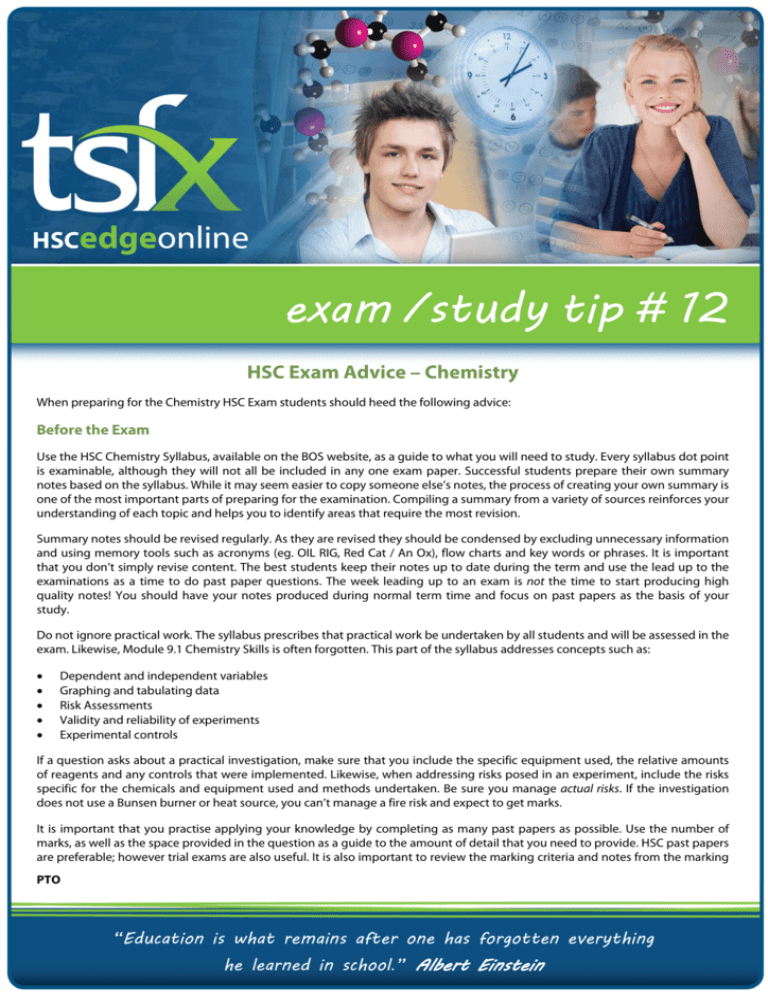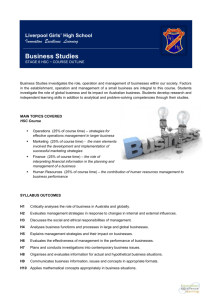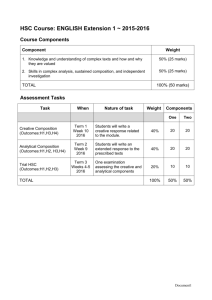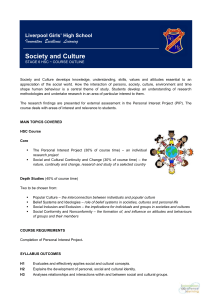exam /study tip # 12
advertisement

HSCedgeonline exam /study tip # 12 HSC Exam Advice – Chemistry When preparing for the Chemistry HSC Exam students should heed the following advice: Before the Exam Use the HSC Chemistry Syllabus, available on the BOS website, as a guide to what you will need to study. Every syllabus dot point is examinable, although they will not all be included in any one exam paper. Successful students prepare their own summary notes based on the syllabus. While it may seem easier to copy someone else’s notes, the process of creating your own summary is one of the most important parts of preparing for the examination. Compiling a summary from a variety of sources reinforces your understanding of each topic and helps you to identify areas that require the most revision. Summary notes should be revised regularly. As they are revised they should be condensed by excluding unnecessary information and using memory tools such as acronyms (eg. OIL RIG, Red Cat / An Ox), flow charts and key words or phrases. It is important that you don’t simply revise content. The best students keep their notes up to date during the term and use the lead up to the examinations as a time to do past paper questions. The week leading up to an exam is not the time to start producing high quality notes! You should have your notes produced during normal term time and focus on past papers as the basis of your study. Do not ignore practical work. The syllabus prescribes that practical work be undertaken by all students and will be assessed in the exam. Likewise, Module 9.1 Chemistry Skills is often forgotten. This part of the syllabus addresses concepts such as: Dependent and independent variables Graphing and tabulating data Risk Assessments Validity and reliability of experiments Experimental controls If a question asks about a practical investigation, make sure that you include the specific equipment used, the relative amounts of reagents and any controls that were implemented. Likewise, when addressing risks posed in an experiment, include the risks specific for the chemicals and equipment used and methods undertaken. Be sure you manage actual risks. If the investigation does not use a Bunsen burner or heat source, you can’t manage a fire risk and expect to get marks. It is important that you practise applying your knowledge by completing as many past papers as possible. Use the number of marks, as well as the space provided in the question as a guide to the amount of detail that you need to provide. HSC past papers are preferable; however trial exams are also useful. It is also important to review the marking criteria and notes from the marking PTO “Education is what remains after one has forgotten everything he learned in school.” Albert Einstein HSCedgeonline centre. These will give you an idea as to what examiners were looking for in students’ responses, as well some advice as to how to go about answering similar questions. All HSC past papers, along with criteria and markers notes are available on the BOS website. Sample answers are also available for papers from 2008 onwards. Books such as ‘Success One Chemistry’, published by the NSW Science Teachers Association, also include Module revision questions and detailed answers to past HSC exam papers. Don’t just practice multiple choice. It is only 1/5th of the entire paper. You need to be proficient at this skill, but if all you are practicing is multiple choice then you’re setting yourself up for disappointment. Only 20% of your study should be focussed here. Why not reward yourself each study session by concluding each 45 minutes of study with 5 multiple choice questions? This is about the ratio of multiple choice questions to short answer questions in your actual HSC examination. Practising as many different types of calculations as possible will ensure that you won’t be put-off by an unusual question. Remember, even if you don’t receive full marks in a calculation question, you will be awarded some marks if you have shown a logical and accurate process. Some tricky calculations are included in many of the standard chemistry texts – such as Conquering Chemistry and Jacaranda’s Chemistry 2. You should try to complete some practise papers under exam conditions. The working time is three hours, with five minutes reading time. Use the suggestions on the front of the page as a guide for the amount of time to spend on each section. This will help you to pace yourself throughout the exam. When practising, remember to answer questions with as much detail as you would in the actual exam. This will prevent you from leaving out important details and help improve your writing speed. During the Exam Read the question carefully and highlight key words, especially the verbs that tell you how you should structure your answer. Have a look at how many marks the question is worth, to give you some idea of the depth that is required. The space provided should also be used as a guide to the amount of detail that you should provide. Always answer the question that is asked. No question ever says, “Write down all you know about…” so make sure you adapt your knowledge to what the question, especially the verb, is asking for. Use tables, diagrams and chemical equations (including states) where appropriate. Answering using dot points is also recommended for extended response questions as it makes your answer easier for the marker to follow. However, make sure that your dot points do not become a summary, and use linking words, such as “Therefore…” and “As a result”…” and “Because of this …”, to link your ideas together. This is particularly important if the question asks you to “evaluate/assess/analyse/justify” where you must use the facts to produce an argument. When asked to “analyse, evaluate or assess” you nearly always need to include an argument for and against. If you don’t emphasise both the positive and negative side of the concept, you will not get the best marks. For example; ethanol is a tantalising replacement for fossil fuels due to its renewability (positive). It is however inferior due to its lower molar heat of combustion and its reliance on arable land for biomass (negative). When assessing ethanol, if you only concentrate on positive or negative aspects you will only get half the possible marks. When addressing a question relating to specific chemicals, examiners generally want to see that you can link structure to properties to function and/or use. Therefore, it is insufficient to simply state the structure of a substance. You also need to describe why the structure produces certain properties and why this enables the substance to be used in a specific way. If appropriate, draw a diagram to support your answer – especially if the question is about an experiment or practical task. A fully labelled diagram of equipment, with details of amounts of reagents and the procedure followed, is just as valid as a long description written using full sentences. Do not guess at a detail in a question. For example, if you want to say when the Haber Process was first developed, but can’t remember the year, don’t guess, as if you are incorrect you may lose marks. Rather, write something a little more general, but correct (i.e. the Haber Process was developed in the early years of the 20th century). PTO voted number one for excellence and quality in hsc programs HSCedgeonline Make sure that you can write balanced chemical equations, including states, for all of the chemical process that you encountered throughout the course. Be sure to balance your equation in terms of both matter and charge, especially redox equations. Don’t expect all questions to ask you to include equations in your answer. Their inclusion can still be part of the marking criteria even if they are not specifically referred to in the question. Chemical equations are the language of Chemistry. The best students use them whenever possible to fully explain a concept. If a question refers to an organic reaction, such as esterification, bromination/addition and polymerisation, make sure that you draw a structural formula and include all of the atoms. Set out your answers to calculation questions clearly. State what you are trying to find or make the unknown the subject of the formula. Include all of the steps that you performed and remember to use correct units. Make sure that you express your answer to the correct number of significant figures. Don’t round off during calculations – use the memory function on your calculator – and you use ALL the digits given in the Periodic table for atomic masses. Most importantly, check that your calculation makes sense – you cannot have a pH of 99.5 and an acid will not have a pH greater than 7. Ration your time. You have 1.8 minutes per mark (1 min: 48 sec) on average for the whole paper. Don’t spend 10 minutes agonising over a two mark question. Move on and come back to it later if you have time. Likewise, if you have spent more than 3 minutes per mark on a question, finish up and move on. If a question is worth 3 or more marks, it is worth your while to write a plan. Include your plan on the actual exam paper. Markers read everything that is written, including a plan that may have important information in it. When drawing a graph, the independent variable is usually on the x-axis and the dependent variable on the y-axis. Use a pencil and ruler and watch out for outlier points, which are not included when drawing a line of best fit. Label axes fully with a scale and units. Try to leave time at the end to review your answers and check for details such as units and states. Finally, try to enjoy the experience! It always feels good to sit an exam that you are well prepared for. Exams can be a great opportunity to demonstrate your knowledge and skill. The markers want to award marks – but you must show them what you know and can do! More subject specific advice will be issued to students at our “Trial Exam Revision Lectures”. Good luck with your exam preparations! TSFX voted number one for excellence and quality in hsc programs









